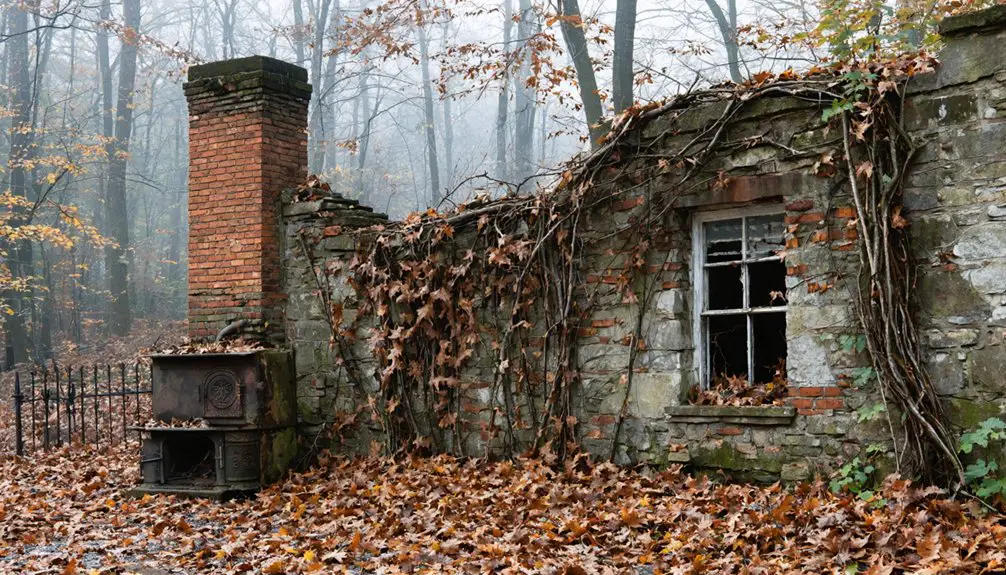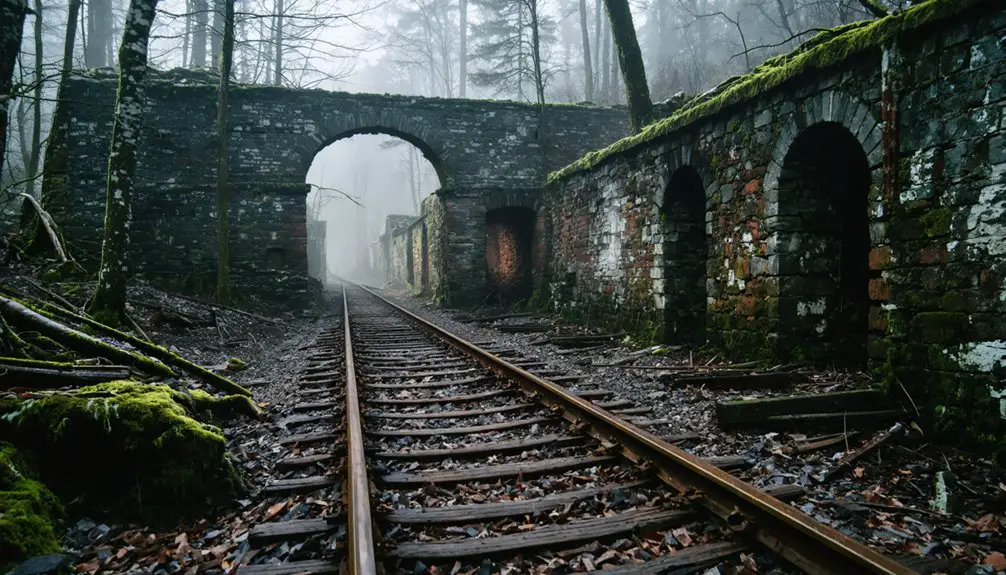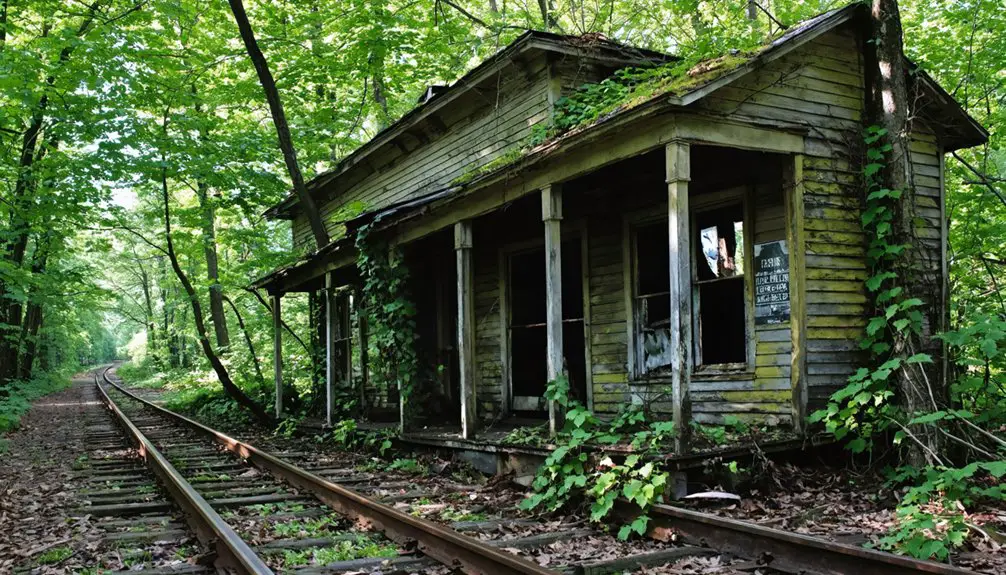You’ll find Carpentertown in Mount Pleasant Township, Pennsylvania, where the Thaw family’s industrial ambitions created a thriving company town in the 1900s. The Mount Pleasant Coke Works, established in 1909, transformed local coal into coke for Pittsburgh’s steel mills using 310 beehive ovens. When operations ceased in 1955, residents abandoned their homes due to mine fires and economic decline. Today, nature reclaims the crumbling ovens and foundations, while untold stories echo through Western Pennsylvania’s forgotten industrial corridor.
Key Takeaways
- Carpentertown transformed from a bustling coal mining town to a ghost town after the closure of Mount Pleasant Coke Works in 1955.
- The town’s decline began when underground mine fires and structural instability forced residents to abandon their homes.
- Former industrial structures, including crumbling coke ovens and home foundations, remain visible through dense undergrowth in modern times.
- Established in 1909, the town flourished with 310 coke ovens and a diverse immigrant workforce before its eventual abandonment.
- The abandoned site features deteriorating infrastructure, an overgrown golf course, and historic railroad grades amid recovering woodland.
The Thaw Family Legacy and Land Origins
While Pittsburgh’s industrial era produced many prominent business families, few left as complex a legacy as the Thaws in Western Pennsylvania’s coal country.
William Thaw Sr., a self-made transportation and railroad magnate, established the family’s influence through extensive land ownership around Mt. Pleasant Township, including what would become Carpentertown.
The Thaw family’s grip on the region tightened through their coal and coke interests, particularly when William Jr. and Benjamin Thaw launched the Hecla Coke Company in the 1880s. Their business acumen was evident as the company was successful enough to be acquired by Frick in 1905.
However, their holdings changed dramatically in the early 1900s when they sold roughly 1,000 acres to the Mount Pleasant Coke Company for $2,000 per acre.
This sale was partly driven by the need to finance Harry K. Thaw’s legal defense in his infamous murder trial.
The Mount Pleasant Coke Company quickly developed the land, constructing 100 double block beehive ovens that first fired in 1909.
Coal and Coke: The Rise of an Industrial Settlement
In 1909, you’d find Mount Pleasant Coke Company establishing Carpentertown’s industrial foundation with 100 double block beehive ovens, transforming raw Connellsville coal into valuable metallurgical coke.
Miners and coke workers soon built their lives around these operations, creating a tight-knit community in Westmoreland County that supported Pennsylvania’s growing steel industry. The area was part of the renowned Pittsburgh coal seam, which produced some of the highest quality coal for metallurgical use. This prosperous but dangerous industry claimed lives over the years, including a devastating methane gas explosion in 1952 that killed six miners at the Carpentertown No. 2 mine.
Industrial Roots Begin
During the early 1900s, Carpentertown’s industrial identity took shape with the establishment of the Mount Pleasant Coke Works on May 5, 1909.
You’d find an impressive operation of 100 double block beehive coke ovens at its start, with industrial expansion bringing an additional 210 rectangular ovens by 1913.
Jacob U. Kuhns and William A. Wilson, seasoned industrialists who managed multiple coal and coke enterprises, spearheaded this venture through the Mount Pleasant Coke Company.
The coke production facility worked in tandem with the nearby Carpentertown mine, located two miles east of Route 981.
This strategic pairing guaranteed a steady supply of bituminous coal for the coke ovens, positioning Carpentertown as a crucial contributor to western Pennsylvania’s booming steel industry, where coke served as an indispensable ingredient. The room-and-pillar mining method was extensively used in the Carpentertown mine, creating a network of coal extraction tunnels supported by rectangular blocks of unmined coal.
Workers Build Community
As the Mount Pleasant Coke Works began operations in 1909, workers and their families quickly established a vibrant company town around the facility.
The community infrastructure grew to support the demanding lives of those who labored in the harsh conditions of coal mining and coke production. With nine different languages spoken among the diverse immigrant workforce, communication became a vital part of daily life. The distinctive rectangular coke ovens marked the industrial character of the settlement.
You’ll find that Carpentertown’s spirit was built on:
- Deep bonds forged between families who shared the daily risks of industrial work
- A network of company-built homes where neighbors looked after one another
- Essential water systems that served both domestic needs and coke production
- Shared experiences of physical labor in the hazardous mine and oven environments
- Pride in contributing to America’s growing steel industry through their work
The town’s development reflected the determination of its residents, who created a close-knit community despite the challenging labor conditions they faced daily.
Fueling Regional Growth
When the Mount Pleasant Coke Works fired up its first 100 beehive ovens in 1909, founders Jacob U. Kuhns and William A. Wilson knew they’d tapped into something big.
You’d have seen their operation expand rapidly, adding 210 rectangular ovens by 1913 to boost coke production considerably.
The plant’s success wasn’t just luck – it was built on the region’s exceptional resources. You could find some of the purest metallurgical coal in the lower Freeport coal bed, matching the quality of famous Connellsville coke.
With abundant water for quenching and rich coal seams beneath their feet, Carpentertown’s operators helped fuel Pennsylvania’s industrial revolution. Their contribution to the regional economy extended beyond the ovens, supporting the growth of coal towns, railroad networks, and the mighty steel industry that defined southwestern Pennsylvania’s destiny. The introduction of coke in the 1850s had already transformed the iron industry, setting the stage for operations like Mount Pleasant Coke Works.
Life in a Pennsylvania Mining Town
Life in Pennsylvania’s mining towns centered around the demanding coal industry that dominated both economic and social structures throughout the region.
You’d find yourself living in a company-controlled town where mining hardships shaped every aspect of daily existence, from the crowded double homes you shared with up to 30 people to the ethnic churches that preserved your cultural heritage. A typical miner earned twenty dollars weekly in 1925, though various deductions drastically reduced take-home pay. Many miners were forced to purchase essential supplies from company stores that charged inflated prices.
- Your family’s survival depended entirely on the mines, with long underground shifts in dangerous conditions.
- You’d likely live in basic company housing without running water or electricity.
- Your neighbors would be fellow immigrants, forming tight-knit ethnic communities.
- You’d rely on your church and cultural institutions for social support.
- Your children would grow up in a town where company control extended to stores, medical care, and schools.
The Path to Abandonment

You’ll find Carpentertown’s decline directly tied to the Thaw family’s financial pressures, which led to the sale of 1,000 acres to Mount Pleasant Coke Company for $2,000 per acre.
This land transaction, prompted by Harry K. Thaw’s legal defense needs, marked the beginning of the town’s industrial transformation and subsequent population loss.
The combination of underground mine fires, structural instability, and the coal industry’s downturn in Pennsylvania forced many residents to abandon their homes, leading to a swift exodus from the once-thriving mining community.
Industrial Decline Takes Hold
The slow deterioration of Carpentertown’s industrial backbone began in earnest during the 1920s, as the Mt. Pleasant Coke Works faced its first major shutdown.
You’ll find that this industrial transformation marked the beginning of a deeper decline that would reshape the community’s future.
- Coke production plummeted as steel manufacturers sought cheaper alternatives
- Local immigrant workers watched their livelihoods vanish as automation took hold
- The once-bustling 310 ovens fell silent, one by one
- Global competition crushed the town’s aging infrastructure
- Environmental regulations and depleted resources delivered the final blow
Despite attempts at community resilience, the plant’s sporadic operations through the 1940s couldn’t sustain Carpentertown’s economy.
When the Carpentertown Coal and Coke Company finally closed in 1955, it sealed the town’s fate in Pennsylvania’s changing industrial landscape.
Population Exodus Accelerates
Following the industrial collapse, Carpentertown’s population began hemorrhaging residents at an alarming rate.
You’ll see this reflected in Warren County’s stark 5.5% population decline between 2010-2018, pushing total residents below 40,000 for two consecutive years.
This exodus mirrors broader trends across rural Pennsylvania, where economic challenges have sparked an accelerating outflow of working-age residents to more prosperous states.
The impact on Carpentertown has been devastating.
As younger families flee to Florida, Texas, and North Carolina in search of better opportunities, they leave behind an aging population and crumbling infrastructure.
You’ll find shuttered schools, reduced emergency services, and a shrinking tax base that can’t sustain basic community needs – hallmarks of a town caught in the grip of severe population decline.
Modern-Day Remnants and Natural Reclamation
While decades of abandonment have erased much of Carpentertown’s original infrastructure, scattered remnants of the Mount Pleasant Coke Works and early 20th-century mining community still dot the landscape.
For urban exploration enthusiasts, you’ll find nature steadily reclaiming this forgotten slice of Pennsylvania’s industrial past through ecological restoration.
- Crumbling coke ovens stand as silent sentinels, slowly surrendering to encroaching vegetation
- Former home foundations peek through dense undergrowth where families once lived
- An abandoned golf course lies hidden beneath nature’s persistent advance
- Rusted irrigation ponds have transformed into thriving wildlife habitats
- Historic railroad grades trace ghostly paths through the recovering woodland
Today, you’ll need to watch your step – unstable ground, venomous copperhead snakes, and deteriorating structures make exploring these industrial ruins an adventure requiring careful navigation.
Historical Significance in Western Pennsylvania

Located at the heart of Western Pennsylvania’s industrial empire, Carpentertown emerged as an essential hub in the region’s coal and coke production during the late 19th century.
You’ll find its legacy deeply intertwined with powerful industrial families like the Thaws, who originally owned the land before selling roughly 1,000 acres to the Mount Pleasant Coke Company at $2,000 per acre.
The town’s significance extends beyond its coal operations – it represents a broader pattern of company towns that shaped Western Pennsylvania’s development.
As one of many resource-driven communities, Carpentertown’s story reflects the region’s economic transformation through industrialization.
The influence of industrial families, immigrant labor forces, and the demands of steel manufacturing all converged here, making it a microcosm of Pennsylvania’s industrial age.
Frequently Asked Questions
Are There Any Remaining Residents Living in Carpentertown Today?
Like embers of a once-roaring fire, current inhabitants do remain in Carpentertown today. You’ll find several families living there, as evidenced by recent home sales and active property taxes in 2024.
What Happened to the Workers After the Town Was Abandoned?
You’ll find workers scattered during the economic decline, with many migrating to nearby coal towns, while others moved to Pennsylvania cities for manufacturing jobs or left the state seeking new industrial opportunities.
Is It Legal to Visit and Explore Carpentertown’s Ruins?
You’ll need explicit permission to explore legally – ghost town regulations and Pennsylvania exploration laws require owner approval for accessing ruins, whether they’re on private or state-owned land.
Were There Any Schools or Churches Built in Carpentertown?
You won’t find documented school history or church architecture in these ruins. While similar coal towns had both, there’s no clear evidence that formal educational or religious buildings existed here.
What Was the Peak Population of Carpentertown During Its Prime?
Like a bustling beehive, this once-thriving ghost town reached its peak population between 500-1,000 residents during its historical significance as a coal and coke production center from 1909-1950s.
References
- http://coalandcoke.blogspot.com/2015/12/mt-pleasant-coke-works-carpentertown-pa.html
- https://pabucketlist.com/the-rise-and-fall-of-centralia-pas-toxic-ghost-town/
- https://www.youtube.com/watch?v=Qj5LjacccJ0
- https://en.wikipedia.org/wiki/Centralia
- https://www.coalcampusa.com/westpa/connellsville/carpentertown-coke-ovens/carpentertown-coke-ovens.htm
- http://coalandcoke.blogspot.com/2017/11/hecla-no-3-coke-works.html
- https://biographics.org/harry-thaw-the-original-killer-playboy/
- https://en.wikipedia.org/wiki/William_Thaw_Sr.
- https://www.pghcitypaper.com/columns/after-a-heinous-1906-murder-two-pittsburghers-found-themselves-in-the-trial-of-the-century-25304011
- https://en.wikipedia.org/wiki/Connellsville_Coalfield



